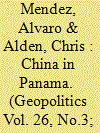|
|
|
Sort Order |
|
|
|
Items / Page
|
|
|
|
|
|
|
| Srl | Item |
| 1 |
ID:
161666


|
|
|
|
|
| Summary/Abstract |
Representative democracies require sufficient numbers of citizens to put themselves forward as candidates for political office. Existing studies have shown that political institutions are not representative of the population as a whole, suggesting that political ambition is not evenly distributed across all potential candidates. We discuss evidence from the first systematic study of political ambition in Britain, examining the question of who is interested in putting themselves forward for political office. We find patterns in the distribution of political ambition that help to explain why British political institutions do not look like the British people as a whole and include a gender gap, a social class gap, an education gap, a north–south divide, and a personality gap. We discuss the implications of our findings for political parties, arguing that they need to adjust practices of candidate recruitment in such a way that minimises the effects of these biases.
|
|
|
|
|
|
|
|
|
|
|
|
|
|
|
|
| 2 |
ID:
178064


|
|
|
|
|
| Summary/Abstract |
The globalisation of China’s development strategy, from its origins as infrastructure diplomacy connecting its domestic west with its Central Asian periphery, into the transnational Belt and Road Initiative encompassing the periphery of the world system, epitomises the rapid evolution of a Chinese grand strategy of great economic and political ambition. The small state of Panama is a key node in the global trading system that can make an unexpectedly large contribution to China’s national security and international influence. Accordingly, China’s economic statecraft in Panama is not only opening up the Latin America and Caribbean markets to further Chinese commercial penetration, but is simultaneously expanding its political influence in this remotest part of the global South. China’s is a two-track grand strategy positing to other nations a choice between a liberal internationalist co-prosperity and a zero-sum realist contest. This audacious approach relies on relational power amongst small states, especially semi-peripheral ones like Panama, to put China at the forefront of what is shaping up as a grand coalition of the global South collectively challenging American hegemony.
|
|
|
|
|
|
|
|
|
|
|
|
|
|
|
|
| 3 |
ID:
132584


|
|
|
|
|
| Publication |
2014.
|
| Summary/Abstract |
China has been surging ahead and pushing for infrastructural development in the western region of the country, which includes the restive areas of the Xinjiang Uighur Autonomous Region (XUAR) and the Tibetan Autonomous Region (TAR). This push is essential if it sincerely wants the often ignored west of the country to be at par with the relatively more thriving east. Included in the government's plans, which began in the year 2000, is the setting up of small-scale industries and factories and also tapping into the vast mineral deposits in the area, and, in the process, generating employment for the locals. Furthermore, plans to improve connectivity within the area are also underway. This includes establishing rail and road networks linking the region, in particular the Tibetan plateau with the mainland. Massive projects are already underway, with some in the second or third phases. Prime among these projects is the ambitious Qinghai-
Tibet Railway (QTR) link.
|
|
|
|
|
|
|
|
|
|
|
|
|
|
|
|
| 4 |
ID:
141644


|
|
|
|
|
| Summary/Abstract |
In this article I claim that the Greek philosopher Xenophon, in the third book of his Memorabilia, catalogues six—and perhaps the six—essential and enduring forms of human ambition. Most treatments of ambition depict the phenomenon as monolithic; or, at best, as dichotomous. That is, ambition is understood as a single trait or passion shared by all ambitious people, its manifestations differing only according to circumstance; or, alternatively, as a trait or passion with one good (or high) form and one bad (or base) form. Little attention is paid to an enterprise of cataloguing various types of human beings as embodying distinct forms of ambition, forms which a political community must tolerate or encourage, channel or confront, in different ways. This enterprise is best carried out through the dialectical approach, in which the personality of a particular interlocutor emerges in light of, and in response to, Socratic scrutiny.
|
|
|
|
|
|
|
|
|
|
|
|
|
|
|
|
| 5 |
ID:
133933


|
|
|
|
|
| Publication |
2014.
|
| Summary/Abstract |
Based on survey responses from a national random sample of nearly 4,000 high school and college students, we uncover a dramatic gender gap in political ambition. This finding serves as striking evidence that the gap is present well before women and men enter the professions from which most candidates emerge. We then use political socialization-which we gauge through a myriad of socializing agents and early life experiences-as a lens through which to explain the individual-level differences we uncover. Our analysis reveals that parental encouragement, politicized educational and peer experiences, participation in competitive activities, and a sense of self-confidence propel young people's interest in running for office. But on each of these dimensions, women, particularly once they are in college, are at a disadvantage. By identifying when and why gender differences in interest in running for office materialize, we begin to uncover the origins of the gender gap in political ambition. Taken together, our results suggest that concerns about substantive and symbolic representation will likely persist.
|
|
|
|
|
|
|
|
|
|
|
|
|
|
|
|
|
|
|
|
|